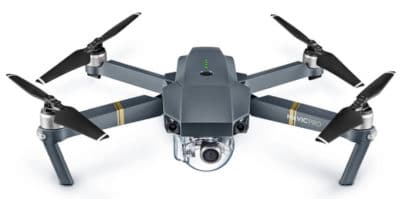This updated DJI Mavic Pro review covers it’s outstanding features, specifications, including frequently asked questions on this superb fold up drone. The Mavic Pro is small and is packed with top drone innovations.
The Mavic Pro has some exciting technology such as 3 active tracking modes, even better hovering precision, more advanced 3D collision avoidance technology, gesture guidance, intelligent flight modes, including variant ground level flying and much more.
This first section of this Mavic Pro highlights and FAQs post will give you a nice overview of this quadcopter’s outstanding features including Mavic Pro specifications.
Then, we answer your frequently asked questions such as the Mavic Pro range, distance, max height, altitude, frequency, sensors, transmission, WiFi, gimbal, camera and much more.
There are also plenty of great Mavic Pro videos throughout.
DJI Mavic Pro Review, Specifications, Features And FAQs
Now, the Mavic Pro is not the latest DJI drone on the market. The latest quadcopters from DJI is the Mini, Mavic Air 2, Mavic Air, and the Mavic 2.
While the Mavic Pro is not the latest DJI drone on the market, it still is a terrific drone and has many positives. It flies super stable and has an excellent camera. Now, what you will get on the Mavic Pro is some great deals, which we have links to below.
Latest Mavic Drones
Mavic Air 2 – Only released in April 2020. Obstacle avoidance, 34 minutes flight time and a superb camera. Here is our Mavic Air 2 review.
Mavic Air – is smaller and has some tremendous features, which are totally new. You can read further on this new quadcopter in our Mavic Air review.
Mavic 2 Pro & Zoom – This are move way more advanced and more expensive. Obstacle detection, collision avoidance and more advanced cameras. You can read about these quadcopters in the Mavic 2 Pro & Zoom review here.
Mavic Mini – tiny and light drone from DJI. The Mavic Mini also has a terrific price. It doesn’t have all the advanced features like Follow Me mode or obstacle detection and collision avoidance. However, it does have a great camera. You can read more in our DJI Mavic Mini review.
Mavic Pro Review & Specifications
We start off with a quick Mavic Pro review below, looking at it’s tremendous features, Mavic Pro specifications, then followed by all the Mavic Pro frequently asked questions.
DJI Mavic Models – Pro, Platinum & Alpine
There are now 3 versions of the DJI Mavic Pro. You have the standard Mavic Pro. The 2nd model is the Mavic Pro Platinum. Then only a few months ago, DJI released an Alpine white version of the Mavic Pro. There is more information on the Platinum Pro below.
What is the Mavic Pro distance range For Live HD Transmission?
The new DJI OcuSync transmission system allows the Mavic Pro to transmit live high definition video streaming at 1080p / 720p from a distance of up to 4.3 miles (7 kilometers). The Mavic Pro range is a big increase of almost 1.25 miles from other DJI models and is well ahead of the competition. The transmission of live video is one of the main reasons why drones of all types have become so popular.
Here is an excellent Mavic Pro distance test which shows the Mavic over some beautiful landscape.
If you would like to understand more about video transmission, then read this article on FPV Live Video, Antenna Gain And Range.
Mavic Pro Max Height
The Mavic Pro max height is listed in the specifications as follows. It has a max service ceiling above sea level of 16,404 feet (5000 meters), which is pretty amazing.
Service ceiling is the maximum altitude, where a 100 foot per minute climb can be maintained. Above the service ceiling you should still be able to climb, but climb performance will be less than 100 feet per minute. Max operating altitude is the maximum altitude it will go. Both are theoretical as there are various factors that would determine the actual values.
Here is a link showing you the Mavic Pro height at 8200 feet over the island of Milos which is a volcanic Greek island in the Aegean Sea.
What Is The DJI Mavic Pro Flight Time?
The Mavic Pro is flying longer than most other consumer drones. The Mavic Pro has an average of 27 minutes flight time with the Platinum having 30 minutes. A extra few minutes means more fun flying and filming.
Mavic Pro Excellent Collision Avoidance System
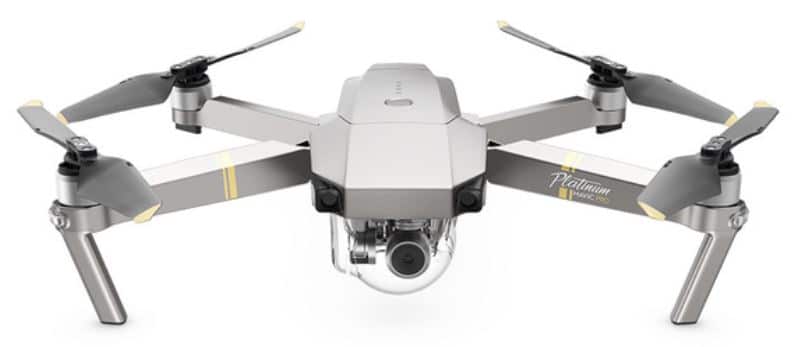
The Mavic Pro has a new “FlightAutonomy” system using vision and ultrasonic sensors to see objects up to 49 feet in front (15 meters) and to avoid these obstacles.
The FlightAutonomy technology gives the Mavic Pro long range, high precision obstacle sensing. This new FlightAutonomy system scans its environment in 3D. This new FlightAutonomy system dramatically increases accuracy and helps the Mavic to locate obstacles around it.
The Mavic Pro FlightAutonomy is made up of 7 components, including 5 cameras (forward and downward dual vision sensors and the main camera), dual band satellite positioning (GPS and GLONASS), 2 ultrasonic rangefinders, redundant sensors and a group of 24 powerful, specialized computing cores.
In general, an ultrasonic range finder sensor enables a drone or robot to detect obstacles in its path by utilizing the propagation of high frequency sound waves. An ultrasonic range sensor such as the Vex EDR Ultrasonic Range Finder sensor emits a 40 kHz sound wave, which bounces off a reflective surface and returns to the sensor.
Then, using the amount of time it takes for the wave to return to the sensor, the distance to the object can be computed. To increase the sensing range, the sensor can be mounted to a servo to allow it to rotate.
The Mavic Pro has cameras on the left and right side along. The cameras on the front of the Mavic are fixed in place using an an aluminum bracket to ensure the optimum alignment of the vision sensor lenses.
Mavic Pro Sensors – Dual Forward And Downward Vision Sensors
As the Mavic Pro flies, dual forward and downward vision sensors measure the distance between itself and obstacles by taking photos from all four cameras and using the information to create a 3D map which tells it exactly where obstacles are.
The dual forward and downward vision sensors require visible light to function, and can see as far as 49 feet (15 meters) in front in bright light.
With forward and downward vision sensors active, the Mavic can fly with total stability indoors or outdoors. The Mavic Pro can detect and avoid or stop before an obstacle which it sees, making flying safer and more reliable.
This obstacle avoidance system is activated in every Intelligent Flight Mode including all ActiveTrack modes, TapFly and Terrain Follow.
It is also available during automatic Return to Home, so that the Mavic can easily make its way back without bumping into anything in its path.
Mavic Pro Price And Bundles
There are some great Mavic Pro bundle available which include extra batteries, chargers, carry case, spare prop and more;
Best Mavic Pro bundles available.
Mavic Pro Super Still Hovering
Using the new “FlightAutonomy” sensor system, the Mavic Pro drone hovers perfectly still.
What is the Mavic Pro operating frequency?
The Operating Frequency of the Mavic Pro remote controller is 2.4 GHz to 2.483. The Mavic Pro WiFi operating frequency is 2.4G / 5G.
Mavic Pro 4K Video On A High Precision Gimbal
For its size the Mavic Pro has a tremendously precise 3 axis gimbal camera which uses every pixel on its sensor. The video and stills shots are just perfect. The Mavic Pro can capture 4k video at 30 frames per second. Here are some of the Mavic Pro video camera highlights;
Mavic Pro Camera Specifications
Sensor – 1/2.3” (CMOS), Effective pixels:12.35 M (Total pixels:12.71 M)
Lens FOV: 78.8° 28 mm (35 mm format equivalent) f/2.2 with distortion of < 1.5% Focus from 0.5 m to ∞
ISO Range: 100-3200 (video)
100-1600 (photo)
Shutter Speed: 8s -1/8000s
Max Image Size: 4000 × 3000
Video Recording Modes as Follows:
C4K: 4096 × 2160 24p
4K: 3840 × 2160 24/25/30p
2.7K: 2704 × 1520 24/25/30p
FHD: 1920 × 1080 24/25/30/48/50/60/96p
HD: 1280 × 720 24/25/30/48/50/60/120p
What Are the Mavic Pro ActiveTrack Intelligent Flight Modes?
The ActiveTrack flight system has 3 modes, which allow tracking of an object or person from different angles allowing for very unique aerial filming and photography shots. The 3 ActiveTrack Modes are as follows;
- Trace – Follow behind, in front or circle a subject as it moves
- Profile – Fly alongside a person or object
- Spotlight – Keep the Mavic camera trained on an object while you fly almost anywhere
Mavic Pro Terrain Follow Mode For Flying Over Uneven Ground
The Mavic Pro can be programmed to fly at the same level above the ground. For example if you are jogging or cycling up a steep hill with the Mavic following you, it will stay at the same level precisely as it follows you up the hill.
Mavic Pro Gesture Mode
With the Mavic Pro in the air and pointing towards you, all you need to is to make a simple frame gesture and the Mavic Pro will take a drone selfie of you.
Mavic Pro With Very Responsive Remoter Controller
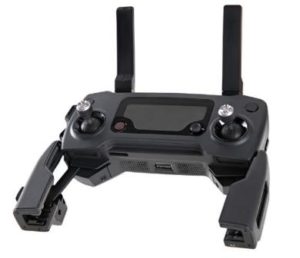 The Mavic RC is very precise to your touch. Everyone who has flown the new Mavic are delighted with the precision responsiveness of the Mavic remote control. It is the best to date and makes flying tremendously easy.
The Mavic RC is very precise to your touch. Everyone who has flown the new Mavic are delighted with the precision responsiveness of the Mavic remote control. It is the best to date and makes flying tremendously easy.
DJI Mavic Pro – Fly With Just Your Phone
You don’t need to always fly using the remote controller. The Mavic can easily be controlled using your smartphone.
DJI Go App
If you have flown any of the DJI models, you will be familiar with the very easy and intuitive DJI Go App. The Mavic also uses the Go App so there is no new software or flight application to get used to.
The DJI Go App allows you to fly the drone and see everything which the drone sees. It also contains all the flight and drone data. This also includes autonomous flight modes and camera settings. With the DJI Go App, you have total control and confidence as you fly.
Difference Between Mavic Pro and Platinum Pro
The new Mavic Pro platinum has the following over the normal Mavic
- Quieter by 4 decibels. The Mavic quadcopter is a pretty quiet anyhow with the Mavic Pro Platinum even quieter.
- Longer flight time to approximately 30 minutes. Well a few minutes of more fun in the sky.
- Longer hover time to 27 minutes.
- New sleek Platinum finish making it look just beautiful.
Can The Mavic Pro Be Used For Surveying, 3D Mapping And Modelling?
Yes. Companies are using the Mavic Pro for commercial photography and filming as it flies super stable, has an excellent camera and loads of manual camera settings. It also hovers superbly still and flies very well indoors making it ideal for multiple sectors such as surveying, filming property and golf courses etc.
The Mavic Pro can also be used for creating 3D maps and models. The Mavic Pro captures excellent still shots and using a top 3D mapping and modelling software, then you can generate excellent 3D data output.
Mavic Pro Quadcopter – What’s In The Box?
The basic Mavic Pro quadcopter, will give you everything in the below list.
- Intelligent Flight Battery
- Gimbal Cover
- Remote Controller
- 3 Pairs of Mavic Propellers
- Mavic Gimbal Clamp
- Charger
- Power Cable
- 16 GB Micro SD Card
- Micro USB Cable
- RC Cable (Lightning connector)
- RC Cable (Standard Micro USB connector)
- 2 x RC Cable Slider
- 4 x Manuals
This next video takes you around the Mavic Pro and shows off its features.
Mavic Pro Review – Frequently Asked Questions
What are the main differences between the Mavic Pro and Phantom 4?
The Mavic is smaller, lighter, and easier to carry because of its fold design. The new OcuSync transmission system has a longer transmission range and 1080p resolution. Due to its larger size, the Phantom 4 has a higher maximum speed and can withstand stronger winds.
Both the Phantom 4 and Mavic have collision avoidance with the latest of this technology being on the Mavic Pro. However, new features are always added by DJI through firmware updates.
Is there any difference between the Mavic Pro and Phantom 4 camera?
The two cameras have the same features. However, the Mavic camera has a smaller field of view (FOV) and is able to focus as closely as 1.64 feet (0.5 meters). The Mavic Pro camera can also be rotated 90° for portrait shots and selfies.
Ad: Check out this superb DJI Mavic 2 Pro deal on Amazon.
The Phantom 4 has a larger FOV which makes it better suited for landscape aerial photography and filming. The Mavic is perfect for following and filming people and objects. The Mavic Pro autonomous intelligent flight modes focus on this type of filming and photography. The Phantom 4 Pro has loads of intelligent autonomous flight modes, which give it more filming and photography options.
Will the Mavic Pro Folding Joints Wear Out?
The folding mechanism has been tested to last at least 5000 folds so the mechanism will last a very long time.
Mavic Pro Remote Controller / WiFi Questions
What is the difference between using the Mavic Pro WiFi vs RC with smartphone?
The Mavic Pro RC uses DJI’s new OcuSync transmission technology giving it a much increased range of up to 4.3 miles (7 km) in open areas without interference. As with all DJI systems, the Mavic Pro is fully FCC compliant.
When using a smartphone connected via WiFi, the controllable range is 262 feet (80 meters) and maximum altitude is 164 feet (50 meters). This makes it great for short-range shots like selfies and for setting up ActiveTrack. You can also download photos and videos directly from the Mavic to your mobile device using the WiFi.
How do I switch between the two controller modes on the Mavic Pro?
First, switch off your Mavic Pro. Next, open the small cover on the right hand side of the Mavic Pro drone. Slide the switch to the left to enable WiFi control, or to the right to use the Mavic Pro Remote Control.
What size of smartphone can fit into the Mavic Pro remote controller?
The Mavic Pro remote controller can fit smartphones between 6.5 to 8.5 mm thick and up to 160 mm long, without a phone case. Phones and tablets larger than this do not fit the remote controller’s device holder.
Can a regular USB cable be used to connect the phone and Mavic Pro remote controller?
Yes. However, for the best experience, DJI recommend that you use a dedicated Mavic Pro Remote Controller Cable to connect your phone.
What Remote Controller Cables come with the Mavic Pro when purchased?
2 cables. One which has a Lightning connector and the other cable is the standard Micro-USB connector.
What is the default Mavic Pro WiFi password and SSID?
For security reasons, each Mavic has its own specially assigned SSID and password which can be found on a sticker on one of the forearms of the Mavic Pro. You will also find this information on the inside of the battery compartment.
For your first use, you can also scan the QR code with the DJI GO app to connect to the aircraft, or enter the password manually under your phone’s WiFi settings. This QR code scanning is only available for Android devices.
Can I use other QR code apps to scan the QR code and connect to the Mavic Pro via WiFi?
No. You must only use the DJI GO app to connect to your quadcopter.
How can I set a new Mavic Pro WiFi password and SSID?
Connect to your Mavic Pro using WiFi. Next, enter Camera View and enter WiFi settings to manually set the SSID and password.
How do I reset the Mavic Pro WiFi password back to default?
Turn on the Mavic Pro in WiFi mode, press the linking button and hold for 5 seconds.
What is the benefit of having a dual-band WiFi on the Mavic Pro?
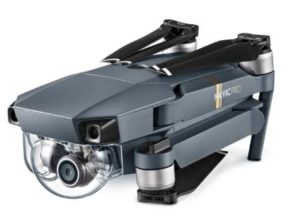 The 2.4G WiFi frequency was developed a long time ago. The 5G WiFi is newer with The U.S. Federal Communications Commission (FCC) approved the spectrum for 5G, including the 28 Gigahertz, 37 GHz and 39 GHz bands, on July 14, 2016.
The 2.4G WiFi frequency was developed a long time ago. The 5G WiFi is newer with The U.S. Federal Communications Commission (FCC) approved the spectrum for 5G, including the 28 Gigahertz, 37 GHz and 39 GHz bands, on July 14, 2016.
As 2.4G is older, more devices use this frequency, making it more likely to suffer from interference.
5G is less prone to interference as there are less 5G devices, but not all phones support the 5G frequency. You can switch between these two frequency bands in the WiFi Settings menu in the DJI GO app.
Mavic Pro Propulsion Questions
Do I have to take the propellers off when travelling?
No. You just need to fold the propellers.
What will happen if the Mavic Pro propellers are not fully unfolded when I try to fly?
Once the rotors start spinning, the centrifugal force will automatically push the propellers and fix them into the correct position, so you don’t need to worry about not having unfolded them perfectly.
What’s the Mavic Pro highest wind resistance?
The Mavic Pro can withstand a level 5 wind, also called a fresh breeze. This is defined as wind speeds of 19–24 mph (29 –38 km/h).
What distance can the Mavic Pro fly on a single battery charge?
In calm weather and under ideal conditions, the Mavic Pro can fly up to 8 miles (13 km range) at 31 mph (50 km/h). Real world performance will vary though, so we urge you to monitor your battery level at all times.
Why does the Mavic Pro have a longer flight time than hover time?
The rotor system is optimized for forward flight and its aerodynamic design is designed for flying at the optimum speed for energy consumption.
Therefore the Mavic consumes less energy when flying than when it is hovering. This is why it is able to give you a 27 minute flight time, while the hover time is 24 minutes.
What is the Mavic Pro Max Altitude Or How High Can The Mavic Fly?
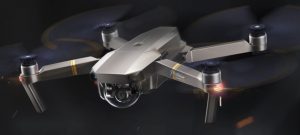 The Mavic Pro has a max altitude (max service ceiling about sea level) of 16,404 feet (5000 meters).
The Mavic Pro has a max altitude (max service ceiling about sea level) of 16,404 feet (5000 meters).
The absolute ceiling is the highest altitude at which an aircraft can sustain level flight, which means the altitude at which the thrust of the engines at full power is equal to the total drag at minimum drag speed.
In other words, it is the altitude where maximum thrust (or power) available from the engines equals the minimum thrust required to keep the aircraft flying at a constant height and speed.
At absolute ceiling, therefore, even with maximum power, the aircraft can no longer accelerate or climb. Stated technically, it is the altitude where the maximum sustained (with no decreasing airspeed) rate of climb is zero.
DJI Mavic Pro Video Transmission
What is the main benefit of the Mavic Pro OcuSync video transmission system?
The Mavic Pro OcuSync transmission gives a range of up to 4.3 miles (7 km) with improved resistance to interference and a higher transmission throughput. At shorter ranges it can stream footage at 1080p resolution and also allows photo and video downloads at 40 MB/s.
What is the Mavic Pro resolution of the live view transmitted using OcuSync?
1080p/30 fps for near field transmission and 720p/60 fps for far-field transmission.
What is the Mavic Pro OcuSync transmission latency?
160 milliseconds from the Mavic Pro camera to your device screen under ideal conditions.
DJI Mavic Pro Sensors System
What is the difference between the Mavic Pro quick and advanced calibration?
When the Vision System fails to function normally, you can do a quick calibration in the DJI GO app or connect the Mavic quadcopter to a computer to perform the advanced calibration for higher precision.
What is the difference between the Mavic Pro Vision Positioning System and an Optical Flow Vision Positioning System?
The Mavic Pro combines dual forward and downward vision sensors for precision hovering. It requires no more than a patterned surface and enough available light to be able to hover very stable up to 42.6 feet (13 meters) above the ground.
If the Mavic Pro is unable to identify reference points on the ground, it can still rely on its forward vision sensors to hover. With an Optical Flow system, it requires information from ultrasonic sensors to supplement its view of patterned surfaces.
An example of the difference between the two systems is when the aircraft is returning to you where you are standing on a balcony.
When flying in over the balcony, a drone using Optical Flow will receive data from two data sources which measure its height above the below surface differently with one being its height above the ground, and another the height above the balcony. As the data is not compatible, an Optical Flow system may become confused.
Another example is when the ground below the drone is covered by vegetation. Plants and trees do not reflect sound as well as other surfaces, causing the Optical Flow system’s ultrasonic sensors to be unable to gather altitude data.
In conclusion, the Mavic Pro superb Intelligent Vision Positioning System requires fewer inputs and is therefore more robust in its functionality.
What is the Mavic Pro minimum distance and maximum flight speed at which the Mavic Pro can fly while avoiding obstacles?
The Mavic will avoid obstacles 50 feet (15 meters) in front of it. The maximum speed at which the Mavic is able to avoid obstacles is 22 mph (30 km/h).
What are the conditions required for Mavic Pro Precision Landing?
Precision Landing is an upgraded version of GPS RTH (Return-To-Home). It needs a GPS signal strong enough to initiate Precision Landing, so that the Mavic can be navigated back to the vicinity of the take-off point.
Then, the drone needs to be able to visually recognize the pattern of the ground it took off from, for example cracks or other identifiable patterns. A uniform patch of sand, however, is not suitable for Precision Landing.
Finally, the Mavic Pro needs to capture footage of the ground during take-off to record its appearance. This means that you should give the Mavic sufficient time during its ascent, instead of flying away immediately after take-off.
DJI Mavic Pro Charging Questions
Can the Mavic Pro charger charge both its Intelligent Flight Battery and its remote controller?
Yes, it can charge a battery and two other devices simultaneously via USB. Note, that it will take longer to fully charge both devices.
Does the Mavic Pro battery support quick charging?
Yes. The Mavic Pro intelligent flight battery supports quick charging at nearly 2 cycles (understanding battery life), with a maximum charging power of 100 watt. The rated power of Mavic Battery Charger is 50 watt, and the rated power of the Mavic Car Charger is 78 watt. When using the Mavic Pro Advanced Charging Hub with a 100 watt adapter, the battery can be charged at 100 watt.
What is a Mavic Pro Battery Charging Hub and what is the difference between the two versions of the Mavic Pro Charging Hubs?
The two Charging Hubs can charge up to 4 batteries at any one time. In order to fully charge the first battery as quickly as possible, the Intelligent Flight Batteries are charged in sequence according to their power levels, from high to low. This gives you the fastest way of getting all your batteries fully charged.
There are two main differences between the two Charging Hubs. The standard Charging Hub only supports the Mavic 50 watt Battery Charger and the Mavic Car Charger, while the advanced version also supports the 100 watt Battery Charger and Car Charger from the Phantom 4.
Also, the advanced battery charging hub version will balance the voltage of each battery cell to improve charging efficiency. When one battery’s charging enters the second-half of its charging phase, the next battery will enter the first-half of its charging phase.
With 4 batteries all at 15%, the advanced charger can get 4 batteries fully charged in 140 minutes using the Phantom 4 100 watt charger, while the standard version will need 270 minutes with the Mavic Pro 50 watt charger.
What is the Mavic battery to Power Bank adapter?
This adapter can be connected to the Mavic Pro Intelligent Flight Battery, turning it into a power bank. With its high capacity, an Intelligent Flight Battery at 25% charge can fully charge the Mavic Pro controller, or an iPhone 6.
What is the maximum output current for the Mavic Pro battery to Power Bank adapter?
The adapter has two USB ports which can be used simultaneously. The output voltage is 5V, and the max current is 2A + 2A.
DJI Mavic Pro Review Videos
Here is a couple of Mavic Pro videos which includes a terrific Mavic Pro review and also the Mavic Pro introduction video.
DJI create top highly innovative drones. Along with that, they sure know how to market their beautiful drones. Here is DJI introducing the beautifully designed Mavic Pro.

